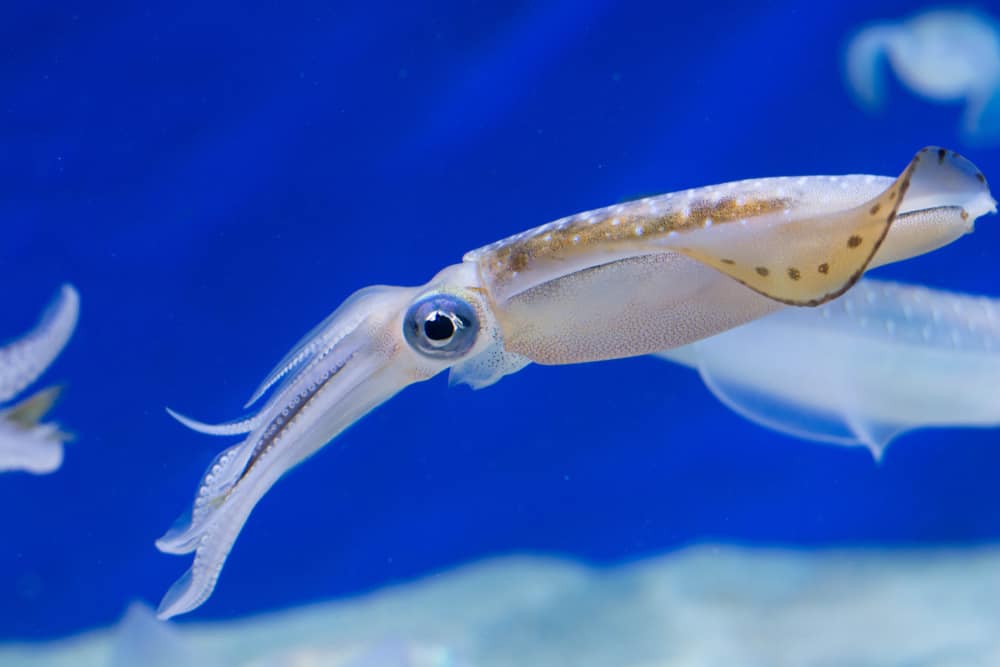The squid is a unique animal among the more than 800 species of marine cephalopods. Unfortunately, these invertebrates love the ocean’s depths, making it difficult for scientists to study them. However, with the passing of time and years of research, many facts about these fascinating animals have been discovered.
In this article, you will learn about their physical characteristics, as well as their behavior, eating habits, and whether they represent any danger to us humans. So, if you are already interested, I invite you to keep reading.
Physical characteristics of the Squids
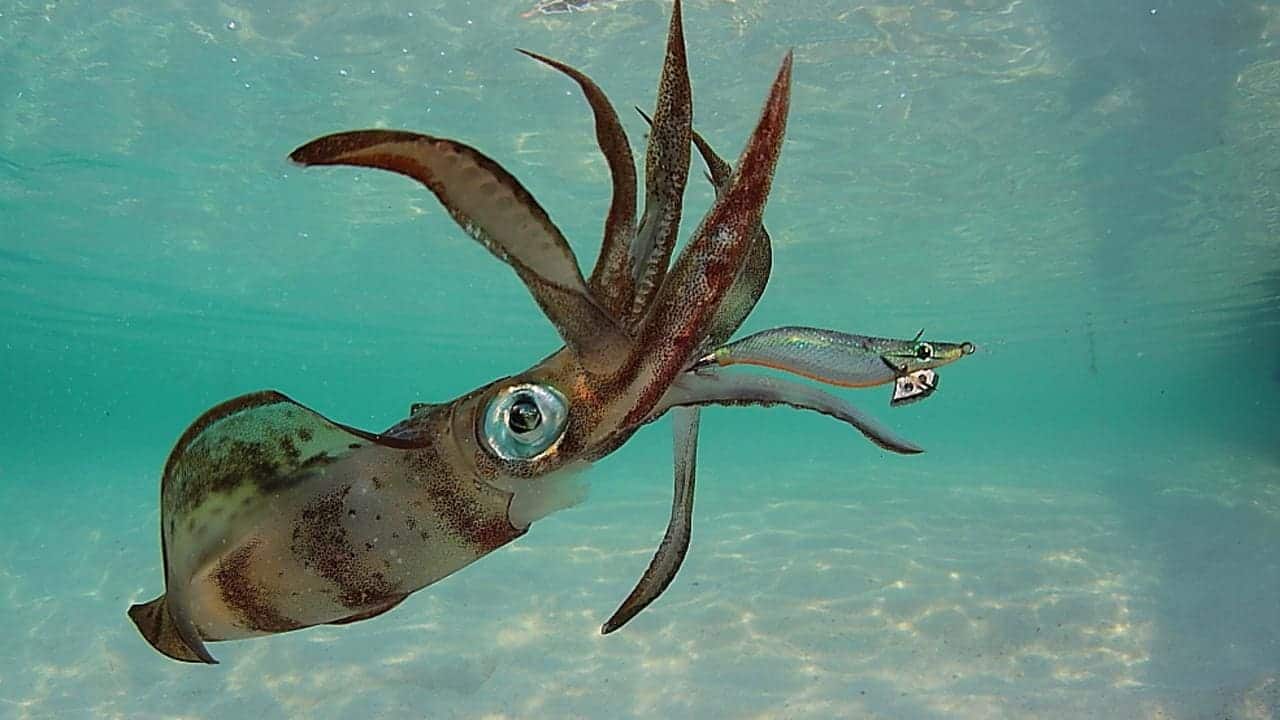
This carnivorous cephalopod mollusk possesses physical characteristics to those of an octopus, like, for example, its invertebrate body and eight tentacles (some squids have up to ten tentacles), and two arms. Its appearance is among the most curious ones in the animal kingdom.
Starting with its head which is elongated and has two eyes, a mouth, and a beak. The eyes are relatively big, allowing them to see a 360-degree view, and their hard beak uses it to kill and eat their prey. But this is not the most exciting trait; like many cephalopods, the right side of the squid’s body mirrors the left half.
This specific trait the scientists have denominated as “bilateral symmetry.” Furthermore, some squids possess special cells in their skin that allow them to change colors, and those which live in deeper waters have bioluminescent organs that can be seen through their skin.
In the same manner, squids are one of the few animals that have several hearts (specifically, three hearts), and along their body, on the sides, they have a pair of fins that allow them to control the direction in which they want to go.
When it comes to size, this can vary, but most of the time, squids can size up to 24 inches, although there are some small squids, like the Southern Pygmy Squid, which can size up to about 1,60 cm almost invisible to the human eye. On the other hand, there are species of giant squid, like the Colossal Squid (Mesonychoteuthis hamiltoni) is the most giant invertebrate known to man, being able to reach sizes up to 46 feet long.
The Nature of the Squids
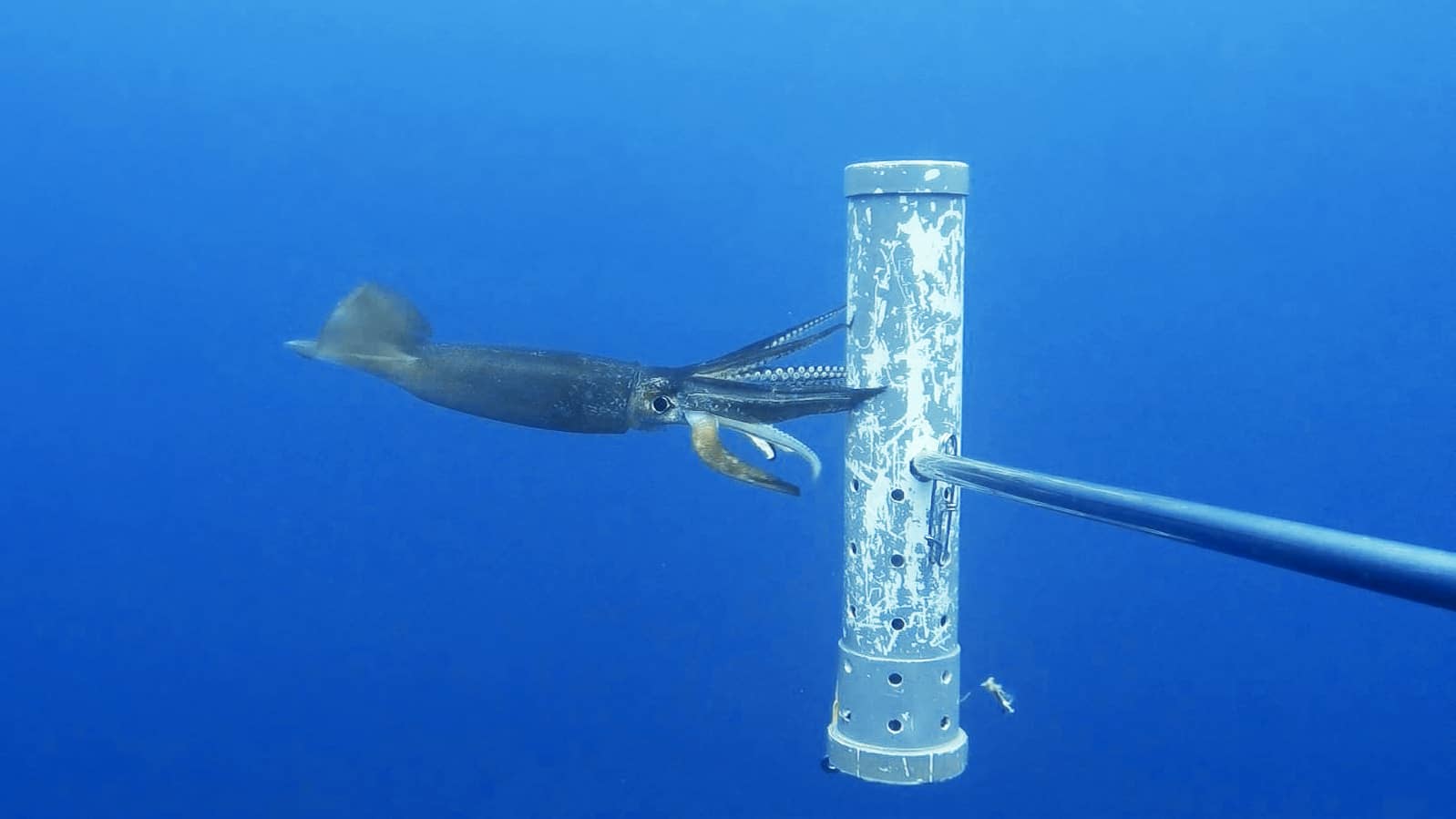
The squids are great swimmers of the oceans and seas; they can reach a maximum speed of 18 mph; this speed is achieved when they take in water through their mantle and then throw it out through their siphon. So basically, this works as a propellant, or a jet-pack if I may say, that propels them in the water.
Likewise, the squid siphon can move and aim in the desired direction, allowing the squid to go as fast as it can to wherever it wants to go. However, when swimming slowly, it does not use its siphon but uses the fins located on the sides of its body.
Depending on their size, squids can have a large or a small number of predators, but they count on some good defenses; for example, those that are able to change colors at will, can match their environment or show a color pattern on their body to camouflage themselves and avoid predators.
In addition, the squids can also spray a dark ink cloud as a self-defense mechanism in case they feel in danger. And this gives them the chance to hide or escape (the vamp squid spray a sticky bioluminescent ink).
The Distribution, habitat, and Life Span of the Squids
Squids can be found in every ocean in the world. Some species prefer to live in cold waters, and others prefer to be in more tropical waters; that is why not all species are found in all parts of the world).
Its population is enormous; scientists have noticed that it even surpasses the population of human beings; furthermore, they play a vital role in the marine ecosystem.
These ocean travelers prefer a lonely life but can huddle up in groups for hunting. Squids do not possess a specific home but rather swim freely, being the bottom of the sea their preference.
Their life span is not entirely clear, but it is believed to be around three to five years since most of them die after they reproduce, except more enormous squids like the colossal or giant squid, which is estimated to have a life expectancy of about 15 years.
What Do Squids Eat?
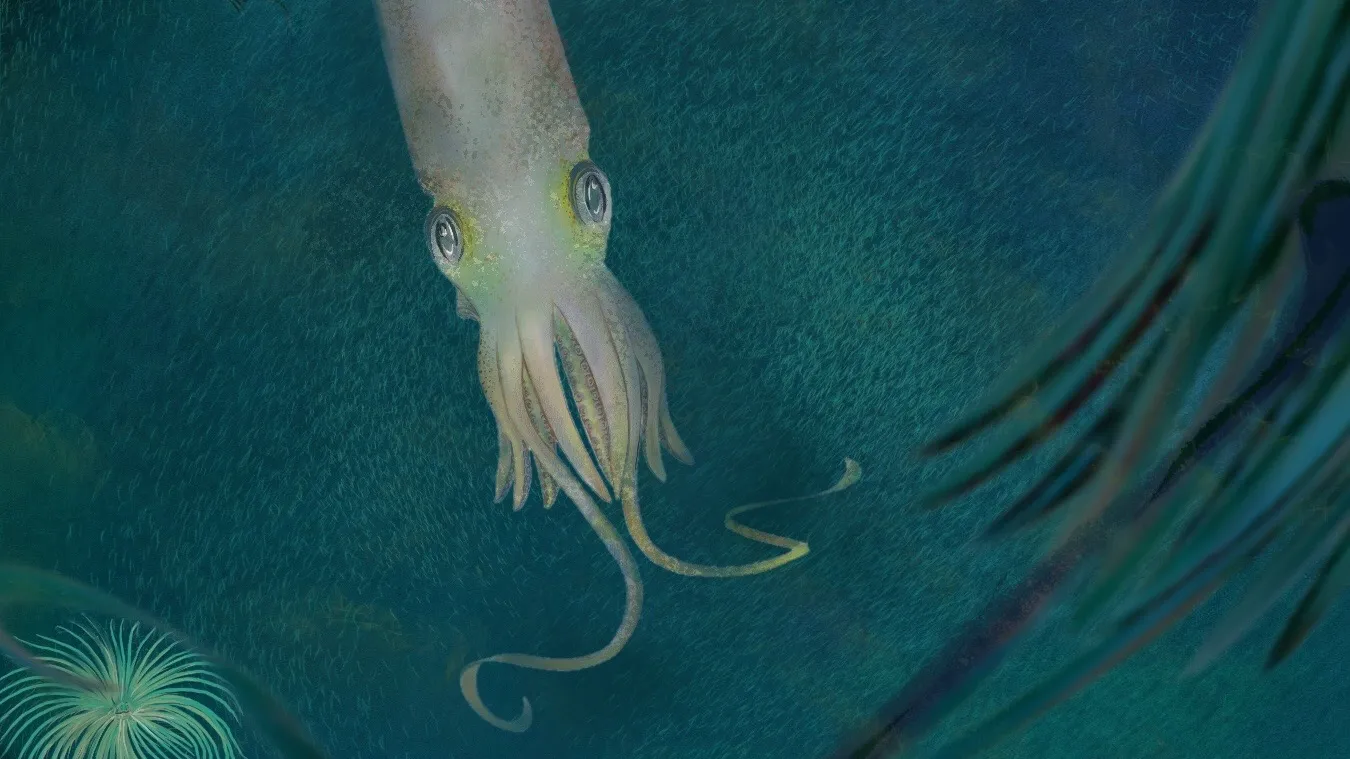
The squids are agile and intelligent carnivores and being on shallow shores and the deep sea, the squid’s diet can be extensive and lengthy. These ocean predators can eat all kinds of things that they can grab with their tentacles.
Some of their more common snacks, which are eaten by almost all of the more than 300 squid species, are deep-sea fish, crabs, shrimps, and oysters. Cannibalism can be found among squids as well since they have no problem eating their own species.
Now then, the squid’s diet depending on the species can be:
- Humboldt Squids: This species of squid is known for its aggressiveness toward its prey, so it feeds on anything it can catch. This is one of the few squids that live in groups and like to hunt on the surface, so they eat a lot of krill and small fishes.
- Giant Squids: This imponent invertebrate can eat all kinds of fish (it loves the Antarctic toothfish), squids, and small fish on riverbanks. It is a lone hunter that is also able to eat different young sharks and whales. It has the particularity of possessing eight tentacles but only uses two of them to capture its prey. It is known that they frequently feed large sea creatures, and even though some are more aggressive, they attack sharks in order to get food; so, due to that, they love large prey, and they tend to confuse ships with prey, that is why there have been many reports of ships being attacked by squids. These reports feed the famous story of the Kraken, a sea monster that attacks ships.
- Flying Squids: Flying squids are distinguished by their solid and hard beaks, which they use to tear their prey easily. They like to eat a diversity of fish and crustaceans. Living in the icy regions of the Arctic and Antarctic, they like to eat krill and plankton, as well as lobsters, crabs, octopus, and smaller squid.
- Longfin Squid: This squid carries a diet where fish conform 70%, where it has a preference for fishes of the North Sea, either cod, swordfish and goby fish, but it also likes crustaceans and, to a lesser extent, cephalopods, such as octopus, nautilus, squid, among others.
- Vamp Squid: With its menacing appearance, one might think it is a ruthless predator. However, observation of the live squid has revealed that it is a very docile creature that lives in the deepest, darkest waters of the ocean and feeds on marine debris. This squid is known as a detritivore and uses its super thin and sticky tentacles to recollect ocean snow particles like detritus, silt, and remains of dead animals.
- Colossal Squid: It tends to be confused with the giant squid, as both are huge and inhabit the ocean’s deep waters. But the colossal squid has different shapes and sizes, also characterized by having the largest eye among squid species. The colossal squid is a territorial animal, which leads it to fight for food with its kind, where huge fish and good-sized sea creatures are its main dish.
- Caribbean Reef Squid: As a smaller squid species, its diet is reduced to less prey, mainly smaller crustaceans, especially amphipods and some small fishes.
What Do Baby Squids eat?
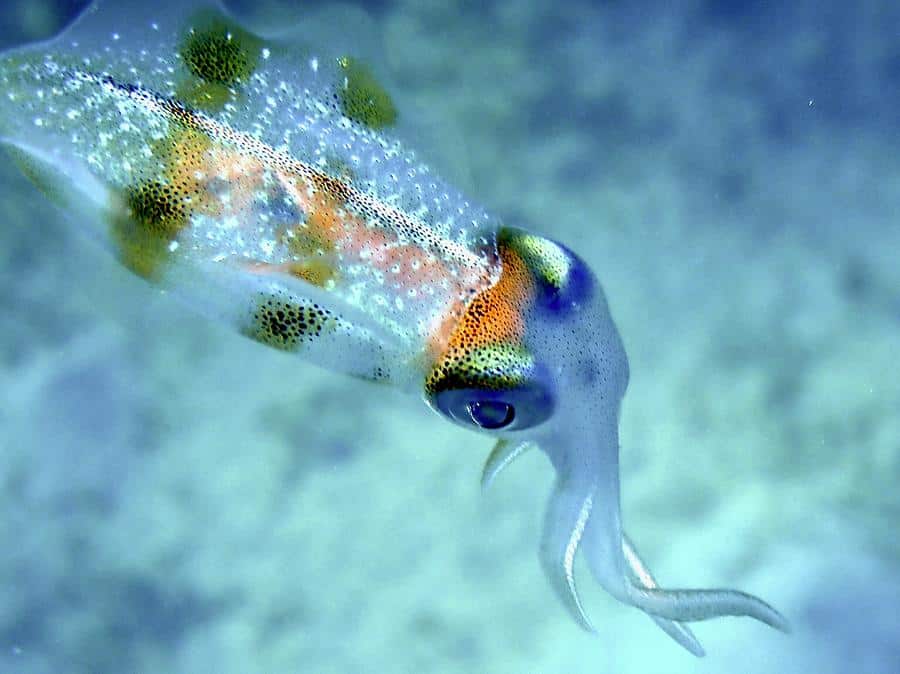
Baby squid, also known as cuttlefish, eat from plankton to small fishes, as well as shrimps, little crabs, krill, and clams; they do this by grabbing their prey with their small tentacles and then sucking them with their mouths.
Baby squid has vegetable material in their diet to supplement their nutrition, which is why eating algae and small plants are common. Other common foods among baby squid are crustaceans, oysters, lantern fish, and orange roughy fish.
Special Behaviors of Squids when It Is Time to Eat
- The squid’s tentacles are covered with suction cups; these suction cups have barbs, which help them hold their prey so that they do not escape and can be eaten.
- A squid’s beak is similar to a parrot’s and uses it to shred its prey before devouring it.
- The squid possesses a structure similar to a tongue, called a radula; this one has a kind of file teeth, these act as grinders, reducing the food to tiny pieces before digesting it.
- Squids have a thin extract that connects through their brain. For this reason, squid must finely chew their food before it is ingested.
- It is estimated that squid consumes about 30% or more of their weight per day.
- Due to their high speed in the water and their color-changing, squid can pounce more efficiently at the moment to catch their food.
How Do Squids Hunt?
Adult squids are lone hunters, most of them hunt at night like the Humboldt squid, but others, like the flying squid, also do it during the daytime. They look for the most opportune moment when their prey is unprepared.
Having a soft flat body with no vertebrae, their mobility in the water is superior to many ocean dwellers. When they are starving, squids wrap their tentacles behind their heads, causing them to approach their prey’s mouth first. Subsequently, they separate their mark and cut them with their sharp beaks while still alive.
In the case of smaller squids, these hunt in groups; in the case of Humboldt squids, which hunt this way, they communicate with each other through their chromatophore, meaning they emit flashes of light and change color.
Other even smaller squids like the pygmy squid are much more cynical when it is time to hunt. This squid blends itself between algae at the bottom of the ocean, and when a shrimp passes by, it gets its tentacles out and grabs it, breaking the shrimp’s nerve cords, leaving it immobile and ready to be digested.
In Conclusion
Although squids resemble octopuses, they are entirely different from cephalopods. Each species has its unique and impressive features, being one of the most amazing marine animals of the oceans, which for now remain much to be known.
As we have learned, they are agile and silent predators, but they are also exposed to other predators, such as sharks, sperm whales, and ourselves, human beings. Their presence in the sea says a lot about the quality of the water, as they leave polluted waters in search of clean water.
And although they live for a short time (it is believed that this is due to their rapid growth), they have a super population all over the world; an essential fact since they represent the main food of animals in danger of extinction, as is the case of the sperm whale.
F.A.Q
Can a Dog Eat a Squid?
Dogs are predatory animals, so in theory, they can eat a squid. But the latter is not in their natural diet, so it is not so common for them to eat it.
Can a Squid Eat a Human?
More enormous squids are able to eat humans if their size is taken into account. However, for them, humans represent a danger to their existence; therefore, they flee when the crossing between the two occurs.
There have been reports of squid attacks on humans, but this has occurred just when they have felt threatened; either way, we must respect this type of animal, as they can be very aggressive and cause severe injuries to us.
Do Squids Eat Dolphins?
Instead, dolphins are among the few animals that eat the largest squid. They enjoy eating squid, and it is even considered to be one of their favorite foods.
